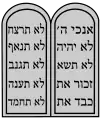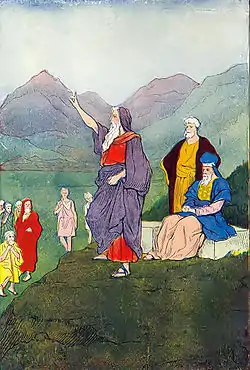Rebbe
A Rebbe (Hebrew: רבי: /ˈrɛbɛ/) or Admor is the spiritual leader in the Hasidic movement, and the personalities of its dynasties.[1] The titles of Rebbe and Admor, which used to be a general honor title even before the beginning of the movement, became, over time, almost exclusively identified with its Tzaddikim.

Terminology and origin
Rebbe
The titles Rebbe and rabbi are both derived from one Hebrew word רַבִּי rabbi [ˈʁabi], which means "(my) master/teacher/mentor", referring to teachers of Torah or leaders of Judaism. This is the way a student would address a master of Torah. It was an honorific originally given to those who had Smicha in the Pharisaic and Talmudic era. The English word rabbi (/ˈræbaɪ/) comes directly from this form. In Yiddish, the word became reb-eh (/ˈrɛbɛ/)—now commonly spelled rebbe (/ˈrɛbə/—or just reb (/ˈrɛb/). The word master רב rav [ˈʁav] literally means "great one".
The Sages of the Mishnah known as the Tannaim, from the 1st and 2nd centuries of the Common Era, were known by the title Rabbi (/ˈræbi/) (for example, Rabbi Akiva and Rabbi Shimon bar Yochoy). Rabbi Yehuda HaNasi, the leader of Jewry in Mishnaic times, was simply called Rabbi (/ˈræbi/), as being the rabbi par excellence of his generation.
The Sages of the Talmud known as the Amoraim, from the 3rd, 4th and early 5th centuries, those born in the Land of Israel, are called Rabbi (/ˈræbi/); those born in the diaspora are known by the title Rav (/ˈrɑːv/).
Usage
| Part of a series on |
| Judaism |
|---|
   |
|
Today, rebbe is used in the following ways:
- Rabbi, a teacher of Torah – Yeshiva students or cheder (elementary school) students, when talking to their teacher, would address him with the honorific Rebbe, as the Yiddish-German equivalent to the Hebrew word rabbi (רַבִּי rabi [ˈʁabi]).
- Personal mentor and teacher—A person's main Rosh Yeshiva, Yeshiva teacher, or mentor, who teaches him or her Talmud and Torah and gives religious guidance, is referred to as rebbe (/ˈrɛbə/),[2] also as an equivalent to the term "rabbi".
- Spiritual leader—The spiritual head of a Hasidic movement is called a rebbe (/ˈrɛbə/).[2] His followers would address him as "The Rebbe" or refer to him when speaking to others as "the Rebbe" or "my Rebbe". He is referred to by others as the Rebbe of a particular Hasidic dynasty. In Hebrew, a Hasidic rebbe is often referred to as an AdMoR, which is an abbreviation for Adoneinu, Moreinu, veRabbenu ("Our Master, our Teacher, and our Rabbi"). In writing, this title is placed before the name of the Hasidut, as in "Admor of Belz"; while the title Rebbe comes after the name of the Hasidut when used as an adjective, as in "Lubavitcher Rebbe", "Amshinever Rebbe", and every rebbe of every Hasidic dynasty. In the Litvishe world, when not referring to a hasidic rebbe (/ˈrɛbə/[2]), the word can be pronounced "rebbee" (/ˈrɛbi/). Sephardic Jews can pronounce it as "Ribbi" (/ˈriːbi/). The Lubavitcher hasidim have a tradition that the Hebrew letters that make up the word rebbe (/ˈrɛbi/) are also an acronym for "Rosh Bnei Yisroel", meaning "a spiritual head of the Children of Israel".
An ordinary communal rabbi, or rebbe in Yiddish, is sometimes distinct from a rav (/ˈræv/, also pronounced rov /ˈrɒv/ by Jews of Eastern European or Russian origin), who is a more authoritative halakhic decider. A significant function of a rav is to answer questions of halakha (corpus of Jewish law), but he is not as authoritative as a posek. The short form reb is an honorific for Orthodox Jewish men, who are most likely to have profound knowledge of the Talmud and Torah, as opposed to Reconstructionist, Reform or Conservative Judaism. Originally, this title was added to the names of Jews at the time of the schism with the Karaite sect, as a sign of loyalty to the original rabbinic tradition, known today as Orthodox Judaism.[3]
Hasidism
As a rule, among hasidim, rebbe (/ˈrɛbə/) is referred to in Hebrew as admor (pl. admorim), an abbreviation for Hebrew adoneinu moreinu v'rabeinu (Hebrew: אדמו"ר acronym for אדוננו מורנו ורבנו), meaning 'our master, our teacher, and our rabbi', which is now the modern Hebrew word in Israel for rebbe.
Hasidim use the term rebbe also in a more elevated manner, to denote someone that they perceive not only as the religious leader or nasi[4] of their congregation, but as their spiritual adviser and mentor. The Rebbe or my Rebbe in this sense is a rav or rabbi whose views and advice are accepted not only on issues of religious law and practice, but in all arenas of life, including political and social issues. Sometimes a Hasid has a rebbe as his spiritual guide and an additional rav for rulings on issues of halakha.
Hasidim use the concept of a (non-Hasidic) rebbe in the simple sense of rabbi, as the Yiddish-German equivalent to the Hebrew word רַבִּי rabi [ˈʁäbi]. For example: "I will ask my rebbe (/ˈrɛbə/), Rabbi (/ˈræbaɪ/) Ploni (so-and-so), for advice about this personal matter."
The Hasidic rebbe
A Hasidic rebbe (/ˈrɛbɛ/) is generally taken to mean a great leader of a Hasidic dynasty, also referred to as "Grand Rabbi" in English or an ADMOR, a Hebrew acronym for Adoneinu-Moreinu-veRabbeinu ("our lord/master, teacher, and rabbi"). Outside of Hasidic circles, the term "Grand Rabbi" has been used to refer to a rabbi with a higher spiritual status. The practice became widespread in America in the early 1900s when Hasidic rebbes began to emigrate to the United States, and was derived from the German Grossrabbiner.
Rabbi Yisroel Baal Shem Tov, the founder of Hasidism, is regarded by Hasidim as the first Hasidic rebbe.[1] During his lifetime he was referred to mainly as "The holy" rather than as "Rebbe", and his disciples were "magidim" or "preachers", such as the Magid of Chernobyl or the Magid of Mezritch.
The first "rebbe" to be known as such was the Baal Shem Tov's grandson, Rabbi Boruch of Mezhibozh, who was referred to as "The Rebbe" during his lifetime. After him, those who rose to positions of leadership and their successors began to be called rebbe. The title gradually came to suggest a higher spiritual status.
Each Hasidic group refers to its leader as "the rebbe".
Hannah Rachel Verbermacher, also known as the Maiden of Ludmir or the "Ludmirer Moyd", was the only female rebbe in the history of the Hasidic movement; she lived in the 19th century in Ukraine and Israel.[5][6]
Rebbe as tzadik
According to Maimonides,[7] a tzadik is "one whose merit surpasses [his/her] iniquity", and every person can reach the level of a Tzadik. According to the Tanya, a tzadik has no evil inclination, and only a select few predestined to attain this level can attain it. According to Kabbalah (and particularly the Hasidic understanding of Kabbalah), the world is sustained on the "shoulders" of Tzadikim Nistarim, divinely predestined exceptionally righteous people in a generation. Nobody has knowledge about who was such a tzaddik, even one of these exceptionally righteous people would not know that they really are such a tzadik. These people are understood to have perfected their personal service of God to such an extent that they become literally and physically aware of God. These righteous people's perception (of both spiritual and physical, not to mention temporal matters) transcends the apparent boundaries of existence.
However, a Hasidic rebbe is generally said to be a righteous person, called a "tzaddik".[1] Furthermore, a rebbe is said to be able to affect divine providence, and a rebbe is said to be able to "see the future", or at least have strong insight into the life and trials of another.
As a result, Hasidim in some Hasidic circles seek their rebbe's advice for a variety of concerns: spiritual, physical, and even business concerns. Furthermore, many people seek the blessing (bracha) of a rebbe (and a Hasid will specifically seek the blessing of his own rebbe) for anything, from minor (and all the more so major) physical troubles, to grand spiritual concerns. Many famous and common stories of a rebbe's intervention involve women who successfully seek a rebbe's blessing for fertility so that they can conceive after having been barren for many years.

Tzadik HaDor
In some movements the Hasidim believe that their rebbe is the "tzadik hador" (tzaddik of the generation) and would regard any thought that detracts from his perfection and holiness as heresy. Other sects lessen this idealization to some degree or another. Since many rebbes are sons-in-law or students of other rebbes, it makes sense that they would view themselves as subordinate to those other rebbes. Nonetheless, their Hasidim remain loyal to them because of their special loyalty, a family connection, or a belief that a specific tzaddik or Nasi HaDor (although others might have greater spiritual stature) connects best with one's soul. For example, the Kosover Rebbe makes yearly pilgrimages to the Tosher Rebbe. Nonetheless, his followers remain very loyal to him.
Rebbe as conduit
Unlike rabbis or non-Hasidic rebbes in other Jewish movements, Hasidic Judaism considers a "hasidic rebbe" to be a conduit between Jews and God.[1] On the basis of traditional Kabbalistic concepts and terminology, Hasidic philosophy bridged deveikut, a Jewish concept referring to closeness to God, to the Hasidic rebbe, embodying and channeling the Divine flow of blessing to the world, because Creation is dependent on the continuous flow of Divine lifeforce, without which it would revert to nothingness.[8]
Hasidic followers of a rebbe
Given a rebbe's physical awareness of God, and the rebbe's transcendent perception of Godliness, many Hasidim take special care to observe the specific and sometimes minute practices of their rebbe. Even things that seem mundane may nonetheless be seen by Hasidim as incredibly significant. For example, Lubavitcher Hasidim frequently shape their fedoras to match the way that the Lubavitcher Rebbe shaped his hat-which was more flat than many others. Many Skverer Hasidim (of the Skverer Rebbe in New Square) wear their peyos identical to those of the Skverer Rebbe. While Hasidim do not always follow the specific practices of their rebbe, the rebbe is able to create practices that may be specific and unique to his Hasidim. For example, Rabbi Aaron Roth (Reb Areleh, as he was called) the first rebbe of Shomer Emunim, told his Hasidim to pause frequently while eating their meals in order to keep them from overindulging. A Hasid will usually love his rebbe like a close family member, if not more so. The degree and nature of this belief varies, however, depending on the movement.
Functions of a Hasidic rebbe

There are some functions which are exclusively the domain of Hasidic rebbes:
A rebbe conducts a tish (Yiddish: פֿירט טיש: feert tish, literally, "to run [a] table") or a farbrengen—a communal festive meal with highly mystical overtones—on Shabbat and other occasions. At a tish, the rebbe distributes shirayim (lit. remnants) to the Hasidim seated at or gathered round the table. When a gathering similar to a tish is led by a rabbi who is not a rebbe (i.e. a Mashpia), it can be referred to as a botte (esp. amongst groups from Romania) or sheves achim.
A rebbe has times when Hasidim (and other petitioners) may come for a private audience. A kvitel (Yiddish for "note", plural kvitlach) is a note with the name of the petitioner and a short request for which the rebbe is asked to pray. The formula in which a person's name is written is one's own Hebrew name, the son/daughter of one's mother's Hebrew name, such as Shimon ben Rivkah (Simeon the son of Rebecca). Hasidim believe that rebbes read supernaturally "between the lines" of a kvitel, and in every Hasidic movement there are numerous anecdotes relating how the rebbe saw things that were not written in the kvitel. In most Hasidic groups, the kvitel is written by the rebbe's gabbai (secretary), however sometimes the petitioner writes it on his own. Usually, but with some exceptions, a pidyon (redemption) of cash is customarily handed to the rebbe under the kvitel, but this is not obligatory. This is considered to be the conduit through which the blessing is given, and a redemption for the soul of the petitioner. ("A gift makes its receiver glad" is given as an explanation: a blessing only comes from a joyous heart.) It is also customary to tip the gabbai, although this too is not obligatory.
Others are not exclusive to Hasidic rebbes, but are often an important part of their role:
- Participating in family celebrations of the Hasidim, such as weddings and brisim (circumcision ceremony)
- Performing mitzvos, etc. in the presence of their Hasidim, such as kindling the Chanuka lights and drawing water with which to bake matzos
- Leading the prayers on Shabbos, Holy Days, and other special occasions
- Delivering learned or inspirational discourses (in Chabad Hasidut, this is one of the main roles of a rebbe)
- Build educational, social and religious institutions [9]
See also
References
- Heilman, Samuel. "The Rebbe and the Resurgence of Orthodox Judaism." Religion and Spirituality (Audio). UCTV, 20 Oct 2011. web. 31 Jul 2013.
- Oxford Dictionary of English, Merriam-Webster's Collegiate Dictionary
- Rabbi Shlomo Zalman Auerbach, Halikhot Shlomo 1:370–373;
Salo Wittmayer Baron, A Social and Religious History of the Jews, vol. 5 p. 283 - Schneerson, Rabbi Menachem Mendel. "The Head". Kabbalah and the Mystical. Chabad-Lubavitch Media Center. Archived from the original on 19 June 2013. Retrieved 25 August 2013.
- "YIVO - Maiden of Ludmir". www.yivoencyclopedia.org. Retrieved 1 May 2018.
- Deutsch, Nathaniel (6 October 2003). The Maiden of Ludmir: A Jewish Holy Woman and Her World. University of California Press. ISBN 9780520927971. Retrieved 1 May 2018 – via Google Books.
- Tractate Yevamot of the Babylonian Talmud 49b–50a: "One whose merit surpasses his iniquity is a tzadik". Mishneh Torah, Sefer Madda, Laws of Repentance 3:1
- God and the Zaddik as the two focal points of Hasidic worship Ada Rapoport-Albert, in Essential Papers on Hasidism edited by Gershon Hundert, NYU Press 1991
- "Vienna Celebrates 'the Most Influential Rabbi of Modern History'". Alexandria, VA. Connection Newspapers. May 7, 2014.
Chabad Tysons Jewish Center will present Paradigm Shift: Transformational Life Teachings of the Lubavitcher Rebbe, a new six-session course by the Rohr Jewish Learning Institute. The course will be offered as part of a series of local activities in Northern Virginia marking 20 years since the passing of "the Rebbe", Rabbi Menachem M. Schneerson of righteous memory. The Rebbe was a visionary religious leader who inspired countless individuals during his lifetime and established a global network of educational, social, and religious institutions to revive the post-holocaust Jewish landscape.